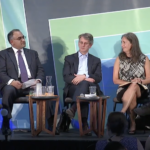Where do you find the potential in your organization?
What makes the light turn on in people’s eyes?
What raises your organization’s collective consciousness?
These are questions many organizations don’t ever consider. Yours, however, is not most organizations. The first step toward doing each of those things — finding potential, sparking light in people’s eyes, and raising the consciousness of your organization — is realizing that you need to ask these questions in the first place.
A culture that evolves with intention and awareness is a brilliant one, and it’s what can — and should — differentiate your organization from others. In other words, most organizations possess inherent greatness that goes unrealized. But in a brilliant culture, this potential is harnessed.
Brilliant cultures proactively adapt to change in ways that decrease stress, inspire learning, and promote organizational success. They reflect the intelligence, invention, and positivity of your people. Better yet, creating this kind of culture doesn’t have to be difficult.
Here’s why: Workplace culture operates as a system, and this system is made up of mindsets, behaviors, and structures. If you think about the culture in your organization, you can see what I mean; the culture is determined by what the individuals in your culture believe, which behaviors are rewarded and encouraged, and the structural design of systems that are in place. These pieces work together in ways that may not be easily understood, but which are no less responsible for all communication, decision-making, and results in your organization.
How to harness your company’s potential
How do you harness the potential in your culture? Let’s say your sales are slipping, mistrust is building, or you want to prepare your culture to move from good to great. Let’s explore a three-phase system for assessing, designing, and integrating intentional change. Using these three phases helps you see your current culture and evaluate it (authenticity), design a plan for transitioning to brilliance (adaptogen design), and then intentionally integrate and adapt the new cultural design (aware integration).
Phase 1: Authenticity. The first phase of the Cultural Brilliance System helps you determine how your cultural system functionally operates, both in how it’s already brilliant—and how it blocks brilliance.
Start by getting to know the culture that already exists. Listen to what people are saying. Ask specific and relevant questions. Practice what you preach. This seems straightforward, but all too often, organizational leaders don’t practice any of these strategies, much less all of them. But how do you do that? You pay attention. You ask questions — and really listen to the answers. You note the emotional energy that surrounds you. Are people happy? Are they angry? If individuals are pushing back, ask why. Sometimes, it may simply be resistance to change, but often there are very good reasons for pushback.
Keep in mind: When you ask people in your organization to be honest with you — and to truly learn the culture, you have to engage in truth-telling — then you must also be honest with them. You can’t change what you don’t thoroughly understand.
Phase 2: Adaptogen Design. The second phase helps you create a design that articulates how your cultural system will functionally transition from its current state to its future brilliant state. From the new place of cultural understanding you uncovered during the Authenticity Phase, you can begin plotting a way forward, intentionally and iteratively. Note places of resistance, and be willing to adapt and role-model new behaviors at every stage.
You can do this by introducing adaptogenic systems, which work together to produce changes. These are iterative systems in that each successful cultural change leads to more of the same. Of course, the flip side of iterative systems is that course corrections can be necessary learning experiences, so it’s incredibly important to be intentional. Ask for feedback, participation, and curiosity from all levels and departments in your company. Identify leverage points that create change. Don’t react. Instead, be proactive and watch how the culture adjusts at each stage of change.
Phase 3: Aware Integration. The third phase helps you plan and implement your cultural design. Do this in three steps:
- Prepare your team for implementation.
- Develop your cultural integration plan.
- Craft a thorough communication and feedback plan.
As before, you must model the change you want to see, you must be patient with your team as everyone embraces change, and you must continue to listen. Implement your plan from the perspective of the new mindsets and behaviors that support your brilliant company culture.
As you create a safe place for individuals to grow and challenge themselves, and as the culture evolves, you’ll see a heightened level of cultural conscious emerge. Reward innovation, integrity, and truth-telling as you address mindsets, behaviors, and structures — and you may just be surprised at how quickly brilliance appears.






